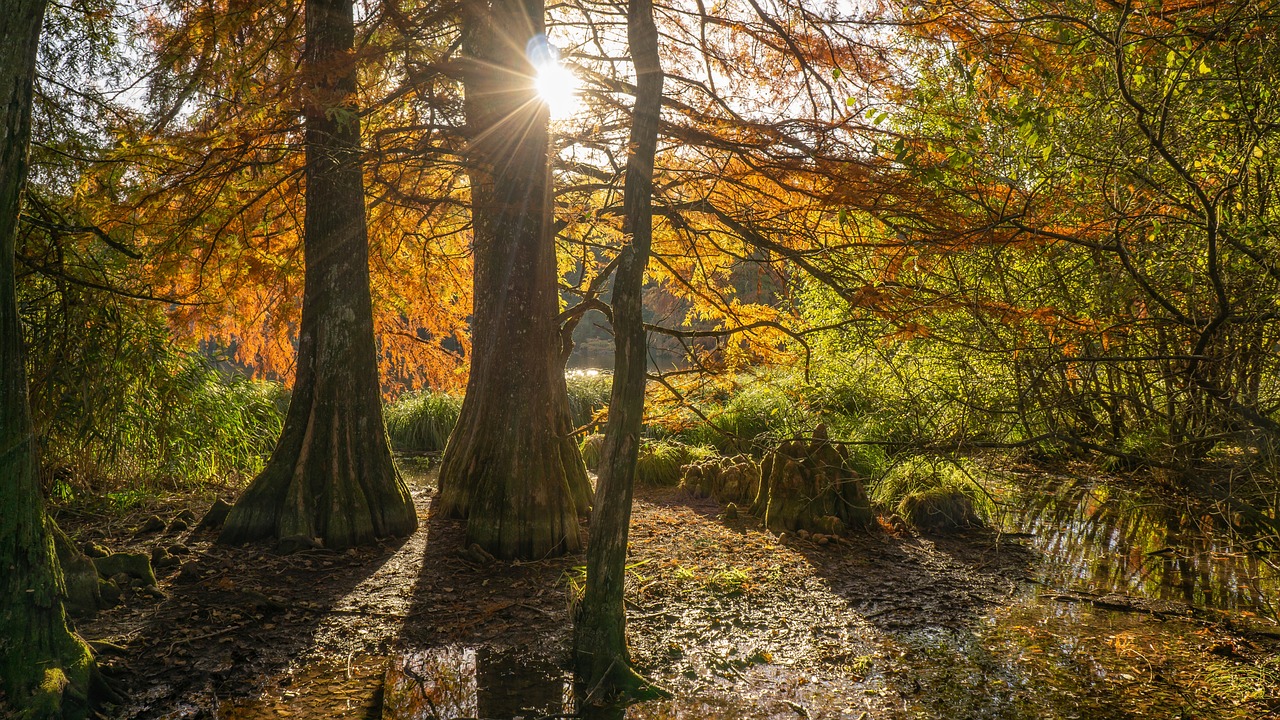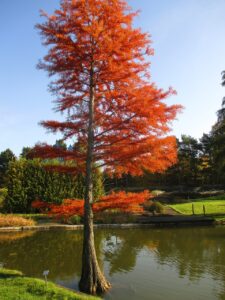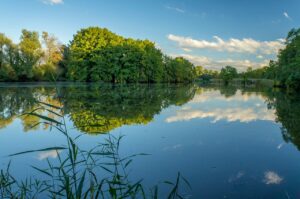Bald Cypress
Overview
The Bald Cypress, or Taxodium distichum, is a captivating deciduous conifer native to American wetlands, especially in Florida’s Everglades and Southern coastal areas1 2 3 4. Thriving in full sun and moist soil, it’s a favorite for its stately form and swamp-loving nature. Adding a touch of mystery to landscapes, it sheds its leaves in fall, marking a seasonal transformation worthy of any garden3.

Characteristics
Known for its deciduous nature, affinity for wet conditions, and distinctive, flared trunk base.
Region
The Bald Cypress is usually found or grown in the Midwest, Southeast, and Mid-Atlantic areas of the United States.
Natural Habitat
Swamps, riverbanks, and wetland areas.
Cultivation
Prefers full sun, thrives in wet to medium-moist soils, and tolerates a variety of soil types including wet, clay, and standing water conditions.
Uses and Benefits
The Bald Cypress (Taxodium distichum) is a versatile and beneficial tree that offers both aesthetic appeal and practical uses in landscaping and gardening.
This majestic tree provides several key benefits:
- Distinctive appearance: Its statuesque form and flared trunk add a touch of mystery and grandeur to any outdoor setting2.
- Adaptability: The Bald Cypress thrives in wet conditions and full-sun environments, making it an ideal choice for enhancing riverbanks, swamps, and other moisture-rich areas3.
- Seasonal interest: With its dynamic seasonal changes, this tree brings life to garden spaces year-round4.
When incorporating the Bald Cypress into your landscaping design, consider the following:
- Its tall stature and distinctive silhouette create visually striking focal points.
- Planting Bald Cypresses along water features or in areas with poor drainage can help stabilize soil and prevent erosion.
- The tree’s adaptability to various soil types and its resistance to many pests and diseases make it a low-maintenance addition to your garden.
By choosing the Bald Cypress, you not only enhance the beauty of your outdoor space but also pay tribute to nature’s artwork, creating a captivating and resilient landscape for years to come.

Cultivation Tips
To cultivate a thriving Bald Cypress tree, ensure you have ample space for this majestic plant to spread its branches. Choose a location that basks in full sunlight, free from the shade of taller plants or structures. This tree’s roots are water-loving, thriving in moist to moderately wet soil. During planting, embrace patience – the Bald Cypress is a slow grower, but with time, it will reward you with a stunning silhouette in your landscape.
While relatively low-maintenance, keep a watchful eye on soil moisture. Bald Cypress trees are accustomed to abundant water and may struggle in overly dry conditions1. Consider these tips for optimal growth:
- Plant in a spacious area with full sun exposure
- Ensure soil remains moist to moderately wet
- Exercise patience during the slow initial growth phase
- Monitor for signs of drought stress and water accordingly
By providing the right environment and care, you’ll cultivate a stunning Bald Cypress that will stand tall in your landscape for years to come.
Seasonal Considerations
When it comes to seasonal considerations, the Bald Cypress tree is a resilient and adaptable plant. It thrives in a wide range of climates, from the hot and humid summers of the Southeast to the cooler, shorter growing seasons of the North. In the fall, the Bald Cypress puts on a spectacular display as its feathery needles turn a stunning russet-red before falling to the ground, leaving behind a striking silhouette of its branches against the sky.
While the Bald Cypress is deciduous, it’s important to note that it doesn’t necessarily lose its needles based on temperature alone. Instead, it enters dormancy based on the length of daylight, shedding its needles as the days grow shorter in the fall. This adaptation allows the tree to conserve energy and resources during the colder months, even in areas where the temperatures may not drop significantly.
As winter sets in, the Bald Cypress becomes a study in texture and form, with its flared, buttressed trunk and its bare, almost sculptural branches. It’s a testament to the tree’s resilience that it can withstand even the harshest of winter conditions, including heavy snow and ice loads.
Come spring, the Bald Cypress bursts back to life, its branches filling out with soft, feathery needles in a vibrant shade of green. It’s a sight to behold as the tree comes back to life, ready to provide shade, beauty, and habitat for wildlife throughout the growing season.
One key seasonal consideration for the Bald Cypress is its love of moisture. In the wild, it’s often found growing in swamps, bayous, and other wetland areas, where it can tolerate periodic flooding and saturated soils1. In the home landscape, it’s important to ensure that the tree receives adequate moisture, especially during the hot, dry months of summer. Regularly watering your Bald Cypress during times of drought can help keep it healthy and thriving.

Issues and Troubleshooting
While the Bald Cypress is a resilient tree, it’s not immune to problems. Poor drainage is a common issue that can lead to root rot, causing the tree to decline. On the other hand, extended periods of drought can also stress the tree, making it more susceptible to pests and diseases.
Although the Bald Cypress is relatively pest-resistant, it can occasionally be affected by:
- Spider mites
- Bagworms
To prevent or manage these issues:
- Ensure proper drainage in the planting area
- Water the tree during prolonged dry spells
- Regularly inspect the tree for signs of pests
- Use organic pest control methods, such as insecticidal soaps or neem oil, if needed
Another aspect to keep in mind is the formation of cypress knees. These unique root projections can grow up to several feet tall and may become obstacles in lawns or walkways. To minimize this issue, consider planting the Bald Cypress away from high-traffic areas or regularly prune the knees if they become problematic.
By staying vigilant and maintaining optimal growing conditions, you can help your Bald Cypress thrive and enjoy its beauty for many years to come. Regular monitoring and prompt action when issues arise are essential for the health and longevity of this magnificent tree in your landscape.
History and Folklore
Draped in mystery, the Bald Cypress tree whispers tales from the wetlands of the Southern United States. This striking tree has woven itself into the fabric of American history and folklore. Ancient Bald Cypresses are often described as silent witnesses to time, their submerged roots resembling the scales of prehistoric creatures lurking in muddy waters.
In Southern folklore, Bald Cypresses are sometimes associated with swamp spirits and old tales of lost bayous. These stories enhance the tree’s enigmatic aura and underscore its cultural significance across generations1.
The Bald Cypress has been a steadfast presence in the American South for millennia. Native Americans used its durable, rot-resistant wood for building houses, canoes, and ceremonial artifacts2. Early European settlers marveled at the tree’s size and longevity, with some specimens believed to be over 1,000 years old.
As the United States expanded westward in the 19th century, the Bald Cypress became an essential resource for the growing nation. Its timber was prized for construction, particularly in the shipbuilding industry4. The tree’s cultural importance grew alongside its economic value, cementing its place in American history.
Today, the Bald Cypress remains an iconic symbol of the Southern landscape. Its distinctive silhouette and ethereal beauty continue to captivate the imagination of nature enthusiasts and folklore aficionados alike. As we explore the tree’s rich history and cultural significance, we gain a deeper appreciation for the enduring legacy of this remarkable species.
References
1. Gardening Know How, “Bald Cypress Growing – Planting A Bald Cypress Tree”, https://www.gardeningknowhow.com/ornamental/trees/cypress/bald-cypress-information.htm
2. Grow it Build it, “Bald Cypress – A Complete Profile On This Native Tree”, https://growitbuildit.com/bald-cypress/
3. The Spruce, “Bald Cypress: Care and Growing Guide”, https://www.thespruce.com/bald-cypress-care-and-growing-guide-5115478
4. American Gardener, “Bald Cypress (Taxodium Distichum)”, https://americangardener.net/bald-cypress/
https://pixabay.com/photos/pond-fall-colors-fire-orange-4600849/
https://pixabay.com/photos/bald-cypress-fall-park-lake-tree-1047682/
https://pixabay.com/photos/pond-lake-landscape-nature-trees-1983875/
Nicolas Duval
Nicolas is a passionate advocate for nature and the art of wildcrafting. His dedication shines through in Wildcraftia, a website he meticulously crafted to serve as a haven for nature enthusiasts worldwide. Driven by a deep appreciation for nature’s connection to humanity, Nicolas embarked on his journey in 2011 with SmokableHerbs, a platform showcasing his love for nature’s bounty. Building upon this foundation, he established Smokably, a thriving online store offering premium herbs and blends to a global audience.
